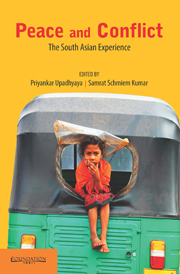Book contents
- Frontmatter
- Contents
- Foreword
- Preface
- Introduction
- 1 Conflict Resolution and Peacebuilding: Ideas, Approaches and Debates
- 2 Changing Perspectives on Peace Studies in South Asia
- 3 Peace Pedagogies in South Asia: Interreligious Understanding
- 4 Responses of Communities to Social Tension
- 5 Plurality of Peace, Non-violence and Peace Works in India
- 6 Education and Culture of Peace: Engaging with Gandhi
- 7 Structural Violence and Human Security: Gandhi's Visions
- 8 Women and the Peace Process in Nepal
- 9 Quest for Peace and Justice in Pakistan: Lawyers' Non-violent Resistance
- 10 Antinomies of Democracy and Peace in Nepal
- 11 Post-armed Conflict Trajectories in Sri Lanka
- 12 Environmental Security and Conflict in Bangladesh: Nature, Complexities and Policies
- Contributors
- Bibliography
- Index
5 - Plurality of Peace, Non-violence and Peace Works in India
Published online by Cambridge University Press: 05 October 2014
- Frontmatter
- Contents
- Foreword
- Preface
- Introduction
- 1 Conflict Resolution and Peacebuilding: Ideas, Approaches and Debates
- 2 Changing Perspectives on Peace Studies in South Asia
- 3 Peace Pedagogies in South Asia: Interreligious Understanding
- 4 Responses of Communities to Social Tension
- 5 Plurality of Peace, Non-violence and Peace Works in India
- 6 Education and Culture of Peace: Engaging with Gandhi
- 7 Structural Violence and Human Security: Gandhi's Visions
- 8 Women and the Peace Process in Nepal
- 9 Quest for Peace and Justice in Pakistan: Lawyers' Non-violent Resistance
- 10 Antinomies of Democracy and Peace in Nepal
- 11 Post-armed Conflict Trajectories in Sri Lanka
- 12 Environmental Security and Conflict in Bangladesh: Nature, Complexities and Policies
- Contributors
- Bibliography
- Index
Summary
Introduction
India is a vast country with multitude perspectives, peoples and ways of life. It is probably the most culturally, ethnically and religiously diverse country in the world. Some of the most prominent philosophies and notions of peace, including non-violence, co-existence, unity and compassion, have emerged from the Indian sub-continent. At the same time, India is also characterized as a state with state and non-state-led violence, political corruption, social injustice and communal divisions. The freedom it gained from the British Raj in 1947 led to mass-violence among its communities, a historical memory that still haunts relations among the South Asian states. India is a country of dissimilarity and contrasts. Peace itself is understood from many perspectives such as plural, relational and sometimes even contradictory. Portraying peace work in the Indian context through a singular lens is, in fact, an impossible task.
This chapter aims at presenting a plurality of philosophies and practices of non-violence and peace works in India. Mohandas K. Gandhi, Vandana Shiva, Mata Amritanandamayi and social movements such as Chipko and Narmada Bachao, represent different understandings of peace, non-violence and peace works. We have chosen to focus on these peace contributors as their efforts and determination led to societal transformations and have inspired many in both India and abroad. Although their messages of peace are comparable, as individuals and social movements, they represent peace work in different historical periods and socio-cultural settings. What all peace workers have in common is that they propagate civil resistance, nonviolence and compassion as powerful tools for personal, social and political transformation. Most of them actively resist(ed) subjugation, by external rulers or the global market economy, both of which are viewed as obstacles for local self-governance and sustainable livelihoods.
- Type
- Chapter
- Information
- Peace and ConflictThe South Asian Experience, pp. 82 - 102Publisher: Foundation BooksPrint publication year: 2014

